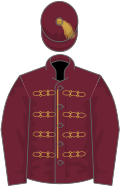Galtres Stakes
The Galtres Stakes is a Listed flat horse race in Great Britain open to fillies and mares aged three years or older. It is run at York over a distance of 1 mile 3 furlongs and 188 yards (2,385 metres), and it is scheduled to take place each year in August. Since 2014 the race has carried the name of Sir Henry Cecil, a former British flat racing Champion Trainer who died in 2013. It is currently held on the second day of York's four-day Ebor Festival meeting.
| Listed race | |
| Location | York Racecourse York, England |
|---|---|
| Race type | Flat / Thoroughbred |
| Sponsor | British EBF |
| Website | York |
| Race information | |
| Distance | 1m 3f 188y (2,385 metres) |
| Surface | Turf |
| Track | Left-handed |
| Qualification | Three-years-old and up fillies & mares exc. Group race winners and Group 1 placed since two years old. |
| Weight | 8 st 12 lb (3yo); 9 st 7 lb (4yo+) Penalties 4 lb for Listed winners* * after 2018 |
| Purse | £70,000 (2019) 1st: £39,697 |
| 2019 | ||
 |
 |
 |
| Search For A Song | Vivionn | Spirit Of Appin |
| Previous years | ||
|---|---|---|
| 2018 | ||
 |
 |
 |
| Lah Ti Dar | Light Of Joy | Sun Maiden |
| 2017 | ||
 |
 |
 |
| Fleur Forsyte | More Mischief | Aljezeera |
| 2016 | ||
 |
 |
 |
| Abingdon | To Eternity | Pandora |
| 2015 | ||
 |
 |
 |
| Martlet | Koora | Dark Crusader |
| 2014 | ||
 |
 |
 |
| Queen Of Ice | Arabian Comet | Noble Protector |
| 2013 | ||
 |
 |
 |
| Our Obsession | Say | Jathabah |
| 2012 | ||
 |
 |
 |
| Pale Mimosa | Sequence | Cracking Lass |
| 2011 | ||
 |
 |
 |
| Set To Music | Cracking Lass | Polly's Mark |
| 2010-2001 | ||
|---|---|---|
| 2010 | ||
 |
 |
 |
| Brushing | Sense Of Purpose | Copperbeech |
| 2009 | ||
 |
 |
 |
| Tanoura | Leocorno | Flame Of Gibraltar |
| 2007 | ||
 |
 |
 |
| Wannabe Posh | Brisk Breeze | Mussoorie |
| 2006 | ||
 |
 |
 |
| Anna Pavlova | Bunood | Gower Song |
| 2005 | ||
 |
 |
 |
| Kastoria | Albahja | Desert Move |
| 2004 | ||
 |
 |
 |
| Tarakala | Selebela | Desert Royalty |
| 2003 | ||
 |
 |
 |
| Mezzo Soprano | Thingmebob | Singleton |
| 2002 | ||
 |
 |
 |
| Alexander Three D | Rosa Parks | Frosty Welcome |
| 2001 | ||
 |
 |
 |
| Inchiri | Panna | Love Everlasting |
| 2000-1994 | ||
|---|---|---|
| 2000 | ||
 |
 |
 |
| Firecrest | Fantasia Girl | Hiddnah |
| 1999 | ||
 |
 |
 |
| Innuendo | Credit-A-Plenty | Sweet Sorrow |
| 1998 | ||
 |
 |
 |
| Rambling Rose | Bristol Channel | Kadaka |
| 1997 | ||
 |
 |
 |
| Kaliana | The Faraway Tree | Book At Bedtime |
| 1996 | ||
 |
 |
 |
| Eva Luna | Time Allowed | Priolina |
| 1995 | ||
 |
 |
 |
| Larrocha | Segovia | Majestic Role |
| 1994 | ||
 |
 |
 |
| Noble Rose | Yenda | Frustration |
Records
Most successful horse since 1988:
- no horse has won this race more than once
Leading jockey since 1988 (7 wins):
- Frankie Dettori – Madiriya (1990), Nibbs Point (1991), Cunning (1992), Mezzo Soprano (2003), Our Obsession (2013), Martlet (2015), Lah Ti Dar (2018)
Leading trainer since 1988 (8 wins):
- Luca Cumani – Madiriya (1990), Nibbs Point (1991), Cunning (1992), Kithanga (1993), Noble Rose (1994), Larrocha (1995), Kaliana (1997), Innuendo (1999)
Winners since 1988
| Year | Winner | Age | Jockey | Trainer | Time |
|---|---|---|---|---|---|
| 1988 | Upend | 3 | Steve Cauthen | Henry Cecil | 2:34.88 |
| 1989 | Knoosh | 3 | Walter Swinburn | Michael Stoute | 2:30.77 |
| 1990 | Madiriya | 3 | Frankie Dettori | Luca Cumani | 2:29.06 |
| 1991 | Nibbs Point | 3 | Frankie Dettori | Luca Cumani | 2:34.86 |
| 1992 | Cunning | 3 | Frankie Dettori | Luca Cumani | 2:28.57 |
| 1993 | Kithanga | 3 | Ray Cochrane | Luca Cumani | 2:33.14 |
| 1994 | Noble Rose | 3 | Michael Kinane | Luca Cumani | 2:29.96 |
| 1995 | Larrocha | 3 | Michael Kinane | Luca Cumani | 2:28.54 |
| 1996 | Eva Luna | 4 | Pat Eddery | Henry Cecil | 2:27.14 |
| 1997 | Kaliana | 3 | John Reid | Luca Cumani | 2:33.76 |
| 1998 | Rambling Rose | 3 | Pat Eddery | Michael Stoute | 2:25.93 |
| 1999 | Innuendo | 4 | John Reid | Luca Cumani | 2:32.24 |
| 2000 | Firecrest | 3 | Richard Quinn | John Dunlop | 2:28.55 |
| 2001 | Inchiri | 3 | Franny Norton | Gerard Butler | 2:30.60 |
| 2002 | Alexander Three D | 3 | Michael Hills | Barry Hills | 2:27.04 |
| 2003 | Mezzo Soprano | 3 | Frankie Dettori | Saeed Bin Suroor | 2:28.85 |
| 2004 | Tarakala | 3 | Michael Kinane | John Oxx | 2:37.68 |
| 2005 | Kastoria | 4 | Michael Kinane | John Oxx | 2:30.36 |
| 2006 | Anna Pavlova | 3 | Paul Hanagan | Richard Fahey | 2:36.60 |
| 2007 | Wannabe Posh | 4 | Eddie Ahern | John Dunlop | 2:33.06 |
| no race 2008 [lower-alpha 1] | |||||
| 2009 | Tanoura | 3 | Michael Kinane | John Oxx | 2:32.64 |
| 2010 | Brushing | 4 | Kieren Fallon | Mark Tompkins | 2:31.97 |
| 2011 | Set To Music | 3 | Jamie Spencer | Michael Bell | 2:35.94 |
| 2012 | Pale Mimosa | 3 | Pat Smullen | Dermot Weld | 2:31.98 |
| 2013 | Our Obsession | 3 | Frankie Dettori | William Haggas | 2:31.99 |
| 2014 | Queen of Ice | 3 | Andrea Atzeni | William Haggas | 2:32.42 |
| 2015 | Martlet | 3 | Frankie Dettori | John Gosden | 2:32.35 |
| 2016 | Abingdon | 3 | Andrea Atzeni | Sir Michael Stoute | 2:33.84 |
| 2017 | Fleur Forsyte | 3 | Daniel Muscutt | James Fanshawe | 2:37.12 |
| 2018 | Lah Ti Dar | 3 | Frankie Dettori | John Gosden | 2:31.22 |
| 2019 | Search For A Song | 3 | Oisin Murphy | Dermot Weld | 2:30.30 |
- The 2008 running was abandoned because of a waterlogged course
gollark: It says ~12% packet loss, which I think is quite bad.
gollark: Regular "mtr" is in the "repos".
gollark: I'm not on "Windows".
gollark: Apparently I also have half the usual upload speed for some horrible reason, so that might be causing it.
gollark: ``` 7: peer7-et-0-1-7.telehouse.ukcore.bt.net 67.970ms 8: 195.99.126.233 26.381ms asymm 7 9: 141.101.71.47 26.857ms asymm 8 10: 172.70.88.137 25.512ms asymm 9 11: 172.70.88.27 31.208ms asymm 10 12: 141.101.106.35 43.680ms asymm 11 13: 141.101.70.144 61.650ms pmtu 1476```I have no idea how to interpret this.
References
This article is issued from Wikipedia. The text is licensed under Creative Commons - Attribution - Sharealike. Additional terms may apply for the media files.